Climate Change Impacts on Agriculture and Adaptation Strategies: A Case Study of Nepal
VerifiedAdded on 2023/06/08
|17
|3904
|409
AI Summary
This chapter discusses the availability scenario of Food and nutrition security in Nepal with a focus on food availability condition, agriculture structure and performance. It also covers the impacts of climate change on agriculture and adaptation strategies.
Contribute Materials
Your contribution can guide someone’s learning journey. Share your
documents today.
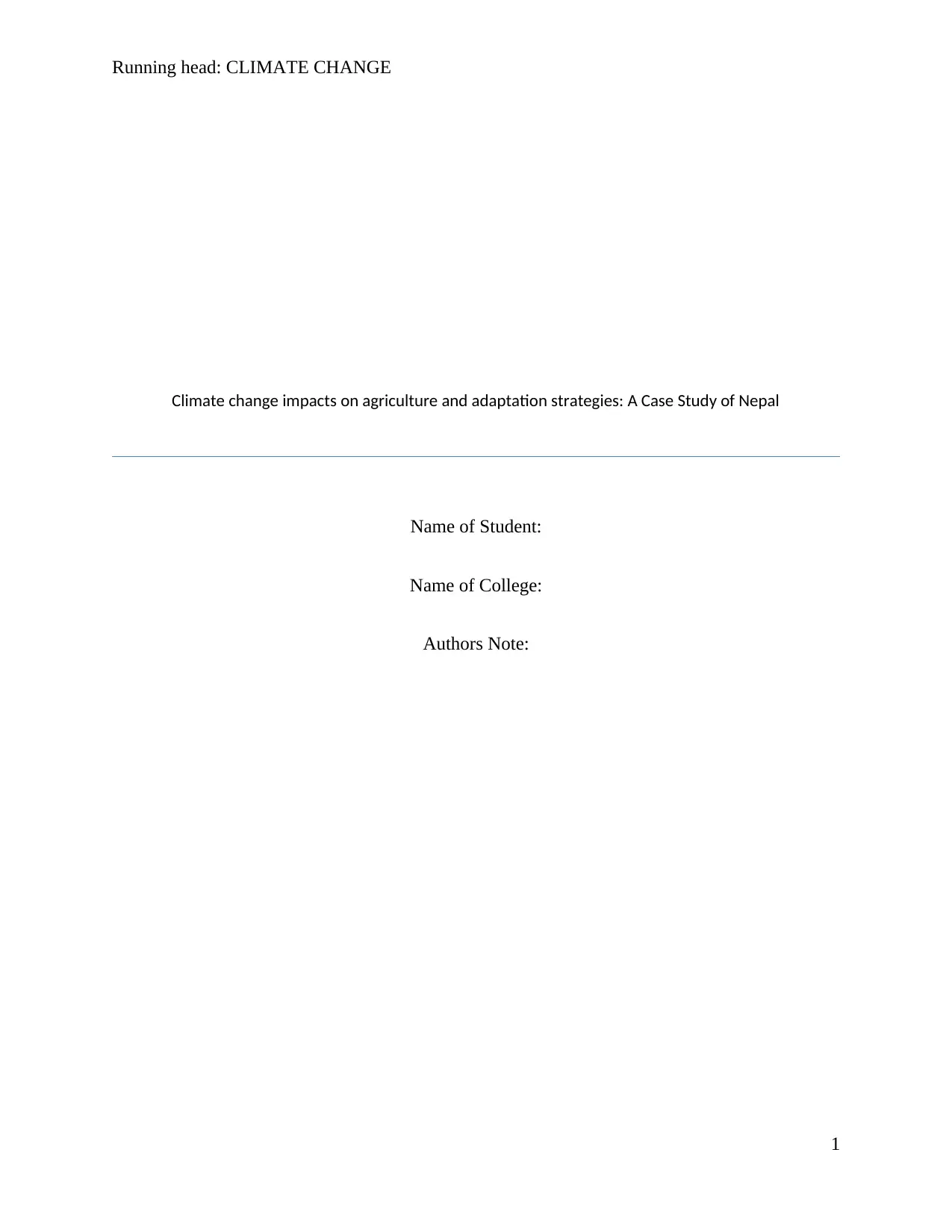
Running head: CLIMATE CHANGE
Climate change impacts on agriculture and adaptation strategies: A Case Study of Nepal
Name of Student:
Name of College:
Authors Note:
1
Climate change impacts on agriculture and adaptation strategies: A Case Study of Nepal
Name of Student:
Name of College:
Authors Note:
1
Secure Best Marks with AI Grader
Need help grading? Try our AI Grader for instant feedback on your assignments.

CLIMATE CHANGE
Contents
Chapter 4: Food and Nutrition security in Nepal.............................................................................3
Introduction......................................................................................................................................3
4.1 Food availability condition....................................................................................................3
4.2 Nepal’s agriculture structure and performance......................................................................4
4.3: Food and Nutrition security..................................................................................................6
Conclusion.....................................................................................................................................11
References......................................................................................................................................13
Figures & Tables........................................................................................................................15
2
Contents
Chapter 4: Food and Nutrition security in Nepal.............................................................................3
Introduction......................................................................................................................................3
4.1 Food availability condition....................................................................................................3
4.2 Nepal’s agriculture structure and performance......................................................................4
4.3: Food and Nutrition security..................................................................................................6
Conclusion.....................................................................................................................................11
References......................................................................................................................................13
Figures & Tables........................................................................................................................15
2

CLIMATE CHANGE
Chapter 4: Food and Nutrition security in Nepal
Introduction
According to Wang, Woo-Kyun & Son (2017) the GDP rate of Nepal gets significant
contribution from agriculture which had been reflecting strong growth across South Asia at rate
of over 33% as reported during 2016. Also agriculture sector in Nepal has around 27% arable
land and 18% cultivated land which supports employment of over 60% of population in the
country. Also agriculture sector of Nepal consumes nearly 0.84% of total emery consumption. A
large section of Nepalese population relies on small household cultivation for their living. Like
specific low caste category families in Nepal maintain landholding with shared crop procedure
which does not produce significant quantity of cultivation for agriculture demand. As such there
persists poverty and inadequacy of access to nutrition and food which is expected to rise further
in shadow of current economic downfall scenario of Nepal. Moreover as result of climate change
the monsoons have become unforeseeable in characteristics and most of the time Nepal does not
get sufficient amount of rainfall as compared to earlier years; as such this low rainfall has
resulted to instable and unanticipated produce of crops which has further elevated the issue of
food insecurity in Nepal (Das & Bandyopadhyay 2015). In this chapter availability scenario of
Food and nutrition security in Nepal will be discussed with focus on food availability condition,
agriculture structure and performance.
4.1 Food availability condition
According to Gartaula, Patel, Johnson, Devkota, Khadka & Chaudhary (2017) the produce of
cereals in Nepal has been outmatched due to huge population surge and in reality the population
increase rate has been significantly larger than the rate of production rise in cereal crops since the
time of 1960’s. A contrast of average annual increase rate through decade of population and
production of cereals in Nepal reflects that the only period during which Nepal witnessed
production increase rate of cereal more than their rate of population rise was during 1981-90.
Impressively this was also the time which coincides simultaneously when Nepal was a prominent
importer of cereal produces. But after consecutive decades the production increase rate has
dropped significantly in Nepal. Moreover according to Joshi, Ji & Narayan (2017) rise in
3
Chapter 4: Food and Nutrition security in Nepal
Introduction
According to Wang, Woo-Kyun & Son (2017) the GDP rate of Nepal gets significant
contribution from agriculture which had been reflecting strong growth across South Asia at rate
of over 33% as reported during 2016. Also agriculture sector in Nepal has around 27% arable
land and 18% cultivated land which supports employment of over 60% of population in the
country. Also agriculture sector of Nepal consumes nearly 0.84% of total emery consumption. A
large section of Nepalese population relies on small household cultivation for their living. Like
specific low caste category families in Nepal maintain landholding with shared crop procedure
which does not produce significant quantity of cultivation for agriculture demand. As such there
persists poverty and inadequacy of access to nutrition and food which is expected to rise further
in shadow of current economic downfall scenario of Nepal. Moreover as result of climate change
the monsoons have become unforeseeable in characteristics and most of the time Nepal does not
get sufficient amount of rainfall as compared to earlier years; as such this low rainfall has
resulted to instable and unanticipated produce of crops which has further elevated the issue of
food insecurity in Nepal (Das & Bandyopadhyay 2015). In this chapter availability scenario of
Food and nutrition security in Nepal will be discussed with focus on food availability condition,
agriculture structure and performance.
4.1 Food availability condition
According to Gartaula, Patel, Johnson, Devkota, Khadka & Chaudhary (2017) the produce of
cereals in Nepal has been outmatched due to huge population surge and in reality the population
increase rate has been significantly larger than the rate of production rise in cereal crops since the
time of 1960’s. A contrast of average annual increase rate through decade of population and
production of cereals in Nepal reflects that the only period during which Nepal witnessed
production increase rate of cereal more than their rate of population rise was during 1981-90.
Impressively this was also the time which coincides simultaneously when Nepal was a prominent
importer of cereal produces. But after consecutive decades the production increase rate has
dropped significantly in Nepal. Moreover according to Joshi, Ji & Narayan (2017) rise in
3

CLIMATE CHANGE
population had reflected a fall only during 2001-08 but yet it is much larger than their cereal rate
of increase and value of net cereal imports reflects a growing trend during the period. Further it
is observed that Nepal has become a net importer of fruits & vegetables since period of mid 90’s
and this shows that the demand for fruits and vegetable have been rising within Nepal but the
rise in domestic produce has not been capable enough to meet this demand. Also it has been
found that there is significant elevation in imports and notable drop in export of cereals and
fruits, vegetable during recent years specifically since 2000 onwards. Though this time coincides
with period of civil instability within Nepal so an in-depth evaluation is needed before inferring
if there is any direct association between the pattern observed previously in exports/imports and
the domestic political condition in Nepal.
According to Byg & Herslund (2016) although Nepal’s domestic generation of cereals as seen in
whole has not been matching with their rise in population within the nation but their per capita
availability of cereals does not reflect concerning fall and has in actuality drifted around 170 kg
per capita per year since the time of 90’s. Import of cereals is eventually the reasoning for
continuing a high availability which has been probable to Nepal’s liberal trade policies. The
tariff of agricultural products has been the lowest within South Asia since 2002 with no tariffs
charged on staples and no quantitative constraints on agricultural products. Although import of
cereals have eventually elevated, Nepal’s import dependency ratio had not been very alerting as
it reached just to 3.5% of overall domestic availability in 2007. While in context to value fruits
and vegetable form a greater share of Nepal’s imports compared to the cereals with fruits and
vegetables consisting of 22.8% of overall agriculture imports since 2007.
4.2 Nepal’s agriculture structure and performance
As observed earlier the contribution of agriculture in GDP of Nepal has relatively increased with
a considerable improvement rate as contrasted to other South Asian nations, which in 2015-16
was nearly 33% of total GDP of Nepal. However both Gross domestic product and GDPA in
Nepal reflects large variations. But in general the GDP and GDPA are likely to project a trend
which reflects the degree that determines agricultural sector of Nepal an overall driver of their
economic stability and development (Sada, Shrestha, Shukla & Melsen (2014) to interpret
performance of agriculture sector in this section the main sub factors of agriculture in Nepal have
been examined. According to Shah, Tachamo, Sharma, Haase, Jähnig & Pauls (2015) the value
4
population had reflected a fall only during 2001-08 but yet it is much larger than their cereal rate
of increase and value of net cereal imports reflects a growing trend during the period. Further it
is observed that Nepal has become a net importer of fruits & vegetables since period of mid 90’s
and this shows that the demand for fruits and vegetable have been rising within Nepal but the
rise in domestic produce has not been capable enough to meet this demand. Also it has been
found that there is significant elevation in imports and notable drop in export of cereals and
fruits, vegetable during recent years specifically since 2000 onwards. Though this time coincides
with period of civil instability within Nepal so an in-depth evaluation is needed before inferring
if there is any direct association between the pattern observed previously in exports/imports and
the domestic political condition in Nepal.
According to Byg & Herslund (2016) although Nepal’s domestic generation of cereals as seen in
whole has not been matching with their rise in population within the nation but their per capita
availability of cereals does not reflect concerning fall and has in actuality drifted around 170 kg
per capita per year since the time of 90’s. Import of cereals is eventually the reasoning for
continuing a high availability which has been probable to Nepal’s liberal trade policies. The
tariff of agricultural products has been the lowest within South Asia since 2002 with no tariffs
charged on staples and no quantitative constraints on agricultural products. Although import of
cereals have eventually elevated, Nepal’s import dependency ratio had not been very alerting as
it reached just to 3.5% of overall domestic availability in 2007. While in context to value fruits
and vegetable form a greater share of Nepal’s imports compared to the cereals with fruits and
vegetables consisting of 22.8% of overall agriculture imports since 2007.
4.2 Nepal’s agriculture structure and performance
As observed earlier the contribution of agriculture in GDP of Nepal has relatively increased with
a considerable improvement rate as contrasted to other South Asian nations, which in 2015-16
was nearly 33% of total GDP of Nepal. However both Gross domestic product and GDPA in
Nepal reflects large variations. But in general the GDP and GDPA are likely to project a trend
which reflects the degree that determines agricultural sector of Nepal an overall driver of their
economic stability and development (Sada, Shrestha, Shukla & Melsen (2014) to interpret
performance of agriculture sector in this section the main sub factors of agriculture in Nepal have
been examined. According to Shah, Tachamo, Sharma, Haase, Jähnig & Pauls (2015) the value
4
Secure Best Marks with AI Grader
Need help grading? Try our AI Grader for instant feedback on your assignments.
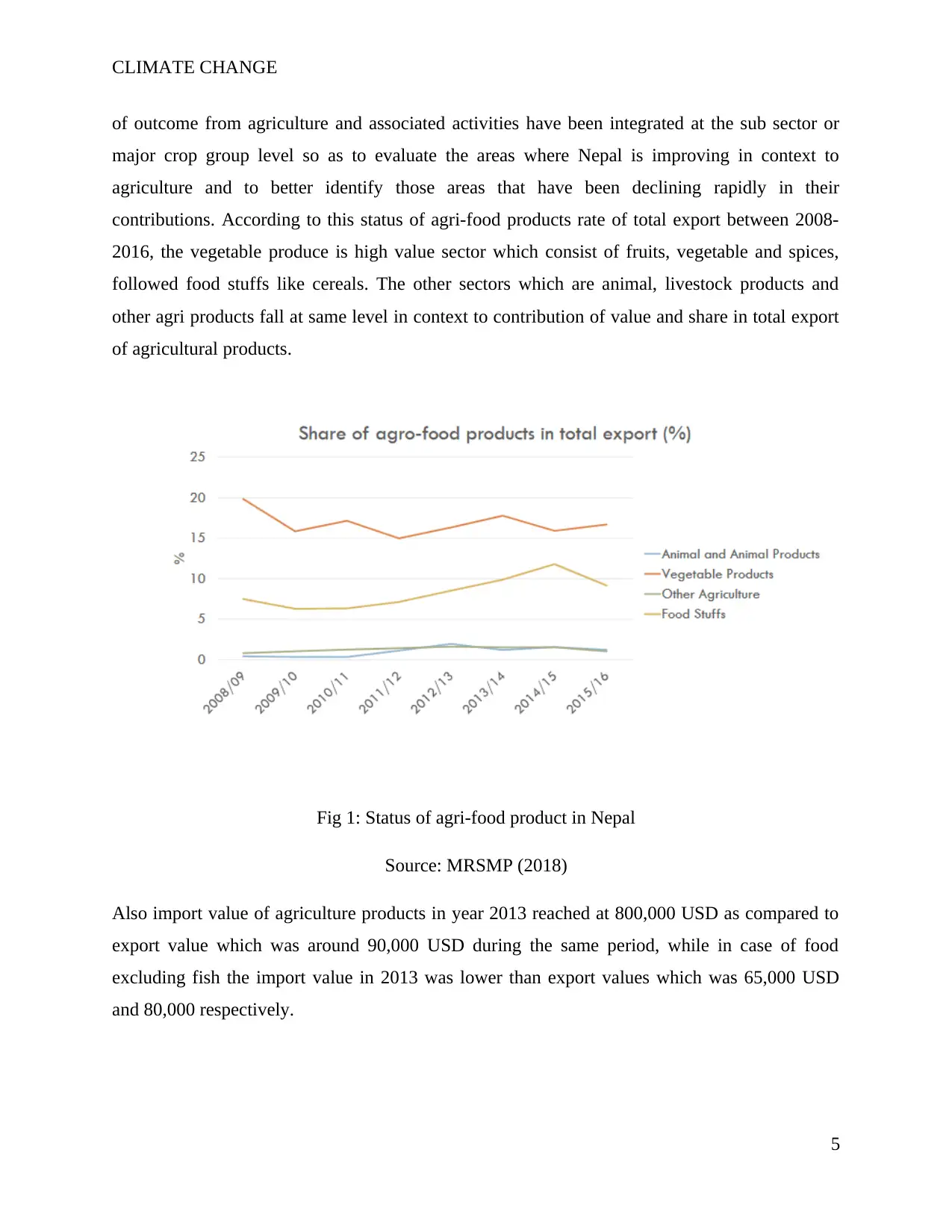
CLIMATE CHANGE
of outcome from agriculture and associated activities have been integrated at the sub sector or
major crop group level so as to evaluate the areas where Nepal is improving in context to
agriculture and to better identify those areas that have been declining rapidly in their
contributions. According to this status of agri-food products rate of total export between 2008-
2016, the vegetable produce is high value sector which consist of fruits, vegetable and spices,
followed food stuffs like cereals. The other sectors which are animal, livestock products and
other agri products fall at same level in context to contribution of value and share in total export
of agricultural products.
Fig 1: Status of agri-food product in Nepal
Source: MRSMP (2018)
Also import value of agriculture products in year 2013 reached at 800,000 USD as compared to
export value which was around 90,000 USD during the same period, while in case of food
excluding fish the import value in 2013 was lower than export values which was 65,000 USD
and 80,000 respectively.
5
of outcome from agriculture and associated activities have been integrated at the sub sector or
major crop group level so as to evaluate the areas where Nepal is improving in context to
agriculture and to better identify those areas that have been declining rapidly in their
contributions. According to this status of agri-food products rate of total export between 2008-
2016, the vegetable produce is high value sector which consist of fruits, vegetable and spices,
followed food stuffs like cereals. The other sectors which are animal, livestock products and
other agri products fall at same level in context to contribution of value and share in total export
of agricultural products.
Fig 1: Status of agri-food product in Nepal
Source: MRSMP (2018)
Also import value of agriculture products in year 2013 reached at 800,000 USD as compared to
export value which was around 90,000 USD during the same period, while in case of food
excluding fish the import value in 2013 was lower than export values which was 65,000 USD
and 80,000 respectively.
5

CLIMATE CHANGE
Fig 2: Import-export of agri-food commodities in Nepal
Source: MRSMP (2018)
4.3: Food and Nutrition security
In this section four elements of food and nutrition security status in Nepal will be discussed
along aspects of food availability, access, utilization and stability. According to te Lintelo &
Lakshman (2015) the availability of food is vital element of food security and it signifies
physical availability of proper level of food within a specific place including a nation as whole.
For most cases production is major source for availability with imports supporting the shortfalls.
Food availability in Nepal will be reviewed on two set of indicators i.e. trends in per capita
cereal or some other foods production and availability and sufficiency of the dietary energy
supplies (DES). According to Green et al. (2017) inspite of long maintained insurgency, political
unrest and large scale immigration of youths from rural belts of Nepal, the production of cereals
have not been affected majorly as much as it is supposed to be. Total production of cereal
6
Fig 2: Import-export of agri-food commodities in Nepal
Source: MRSMP (2018)
4.3: Food and Nutrition security
In this section four elements of food and nutrition security status in Nepal will be discussed
along aspects of food availability, access, utilization and stability. According to te Lintelo &
Lakshman (2015) the availability of food is vital element of food security and it signifies
physical availability of proper level of food within a specific place including a nation as whole.
For most cases production is major source for availability with imports supporting the shortfalls.
Food availability in Nepal will be reviewed on two set of indicators i.e. trends in per capita
cereal or some other foods production and availability and sufficiency of the dietary energy
supplies (DES). According to Green et al. (2017) inspite of long maintained insurgency, political
unrest and large scale immigration of youths from rural belts of Nepal, the production of cereals
have not been affected majorly as much as it is supposed to be. Total production of cereal
6
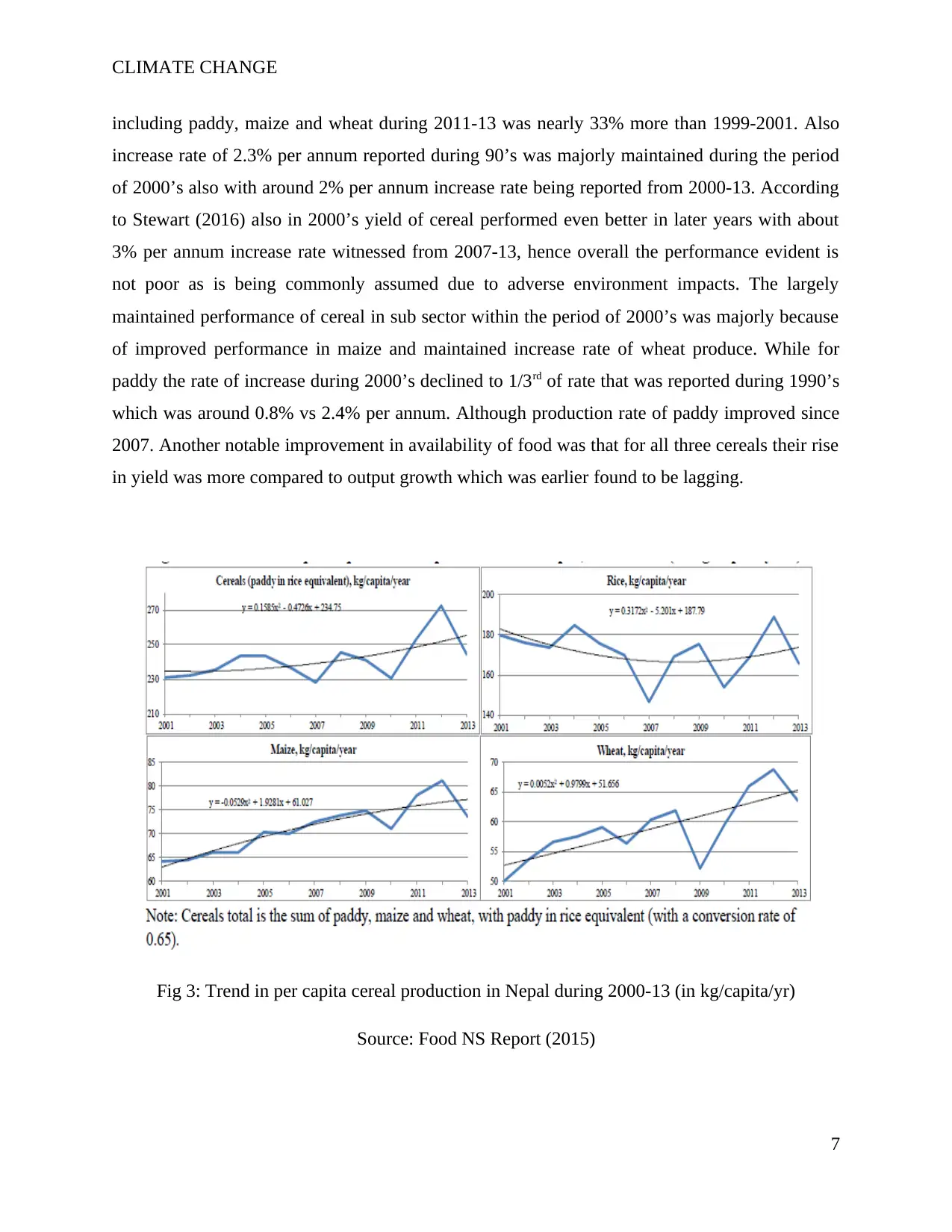
CLIMATE CHANGE
including paddy, maize and wheat during 2011-13 was nearly 33% more than 1999-2001. Also
increase rate of 2.3% per annum reported during 90’s was majorly maintained during the period
of 2000’s also with around 2% per annum increase rate being reported from 2000-13. According
to Stewart (2016) also in 2000’s yield of cereal performed even better in later years with about
3% per annum increase rate witnessed from 2007-13, hence overall the performance evident is
not poor as is being commonly assumed due to adverse environment impacts. The largely
maintained performance of cereal in sub sector within the period of 2000’s was majorly because
of improved performance in maize and maintained increase rate of wheat produce. While for
paddy the rate of increase during 2000’s declined to 1/3rd of rate that was reported during 1990’s
which was around 0.8% vs 2.4% per annum. Although production rate of paddy improved since
2007. Another notable improvement in availability of food was that for all three cereals their rise
in yield was more compared to output growth which was earlier found to be lagging.
Fig 3: Trend in per capita cereal production in Nepal during 2000-13 (in kg/capita/yr)
Source: Food NS Report (2015)
7
including paddy, maize and wheat during 2011-13 was nearly 33% more than 1999-2001. Also
increase rate of 2.3% per annum reported during 90’s was majorly maintained during the period
of 2000’s also with around 2% per annum increase rate being reported from 2000-13. According
to Stewart (2016) also in 2000’s yield of cereal performed even better in later years with about
3% per annum increase rate witnessed from 2007-13, hence overall the performance evident is
not poor as is being commonly assumed due to adverse environment impacts. The largely
maintained performance of cereal in sub sector within the period of 2000’s was majorly because
of improved performance in maize and maintained increase rate of wheat produce. While for
paddy the rate of increase during 2000’s declined to 1/3rd of rate that was reported during 1990’s
which was around 0.8% vs 2.4% per annum. Although production rate of paddy improved since
2007. Another notable improvement in availability of food was that for all three cereals their rise
in yield was more compared to output growth which was earlier found to be lagging.
Fig 3: Trend in per capita cereal production in Nepal during 2000-13 (in kg/capita/yr)
Source: Food NS Report (2015)
7
Paraphrase This Document
Need a fresh take? Get an instant paraphrase of this document with our AI Paraphraser
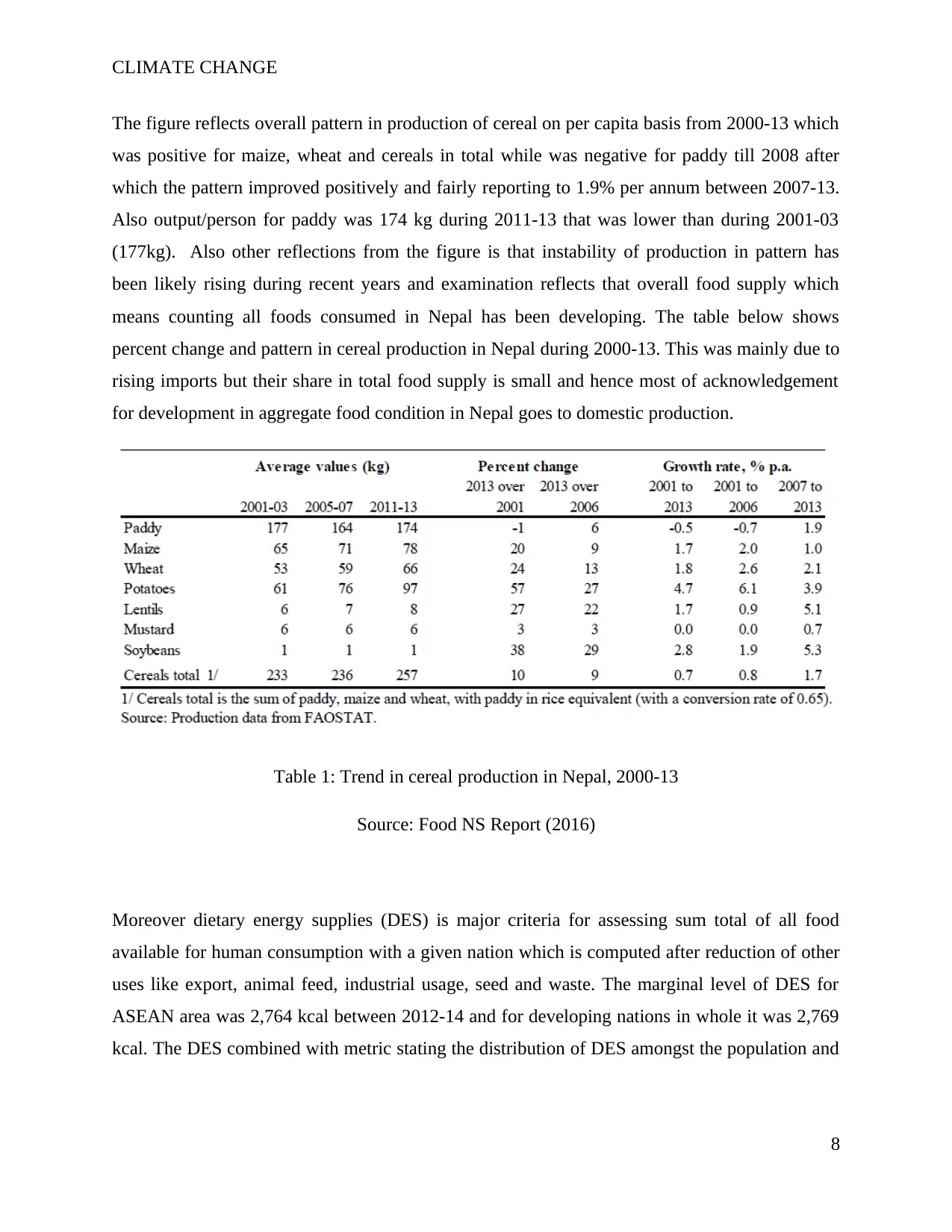
CLIMATE CHANGE
The figure reflects overall pattern in production of cereal on per capita basis from 2000-13 which
was positive for maize, wheat and cereals in total while was negative for paddy till 2008 after
which the pattern improved positively and fairly reporting to 1.9% per annum between 2007-13.
Also output/person for paddy was 174 kg during 2011-13 that was lower than during 2001-03
(177kg). Also other reflections from the figure is that instability of production in pattern has
been likely rising during recent years and examination reflects that overall food supply which
means counting all foods consumed in Nepal has been developing. The table below shows
percent change and pattern in cereal production in Nepal during 2000-13. This was mainly due to
rising imports but their share in total food supply is small and hence most of acknowledgement
for development in aggregate food condition in Nepal goes to domestic production.
Table 1: Trend in cereal production in Nepal, 2000-13
Source: Food NS Report (2016)
Moreover dietary energy supplies (DES) is major criteria for assessing sum total of all food
available for human consumption with a given nation which is computed after reduction of other
uses like export, animal feed, industrial usage, seed and waste. The marginal level of DES for
ASEAN area was 2,764 kcal between 2012-14 and for developing nations in whole it was 2,769
kcal. The DES combined with metric stating the distribution of DES amongst the population and
8
The figure reflects overall pattern in production of cereal on per capita basis from 2000-13 which
was positive for maize, wheat and cereals in total while was negative for paddy till 2008 after
which the pattern improved positively and fairly reporting to 1.9% per annum between 2007-13.
Also output/person for paddy was 174 kg during 2011-13 that was lower than during 2001-03
(177kg). Also other reflections from the figure is that instability of production in pattern has
been likely rising during recent years and examination reflects that overall food supply which
means counting all foods consumed in Nepal has been developing. The table below shows
percent change and pattern in cereal production in Nepal during 2000-13. This was mainly due to
rising imports but their share in total food supply is small and hence most of acknowledgement
for development in aggregate food condition in Nepal goes to domestic production.
Table 1: Trend in cereal production in Nepal, 2000-13
Source: Food NS Report (2016)
Moreover dietary energy supplies (DES) is major criteria for assessing sum total of all food
available for human consumption with a given nation which is computed after reduction of other
uses like export, animal feed, industrial usage, seed and waste. The marginal level of DES for
ASEAN area was 2,764 kcal between 2012-14 and for developing nations in whole it was 2,769
kcal. The DES combined with metric stating the distribution of DES amongst the population and
8

CLIMATE CHANGE
normative minimum need demonstrates situation of undernourishment or food insufficiency in a
nation.
Fig 4: Trend in DES and their sufficiency level for Nepal and other South Asian regions
Source: Food NS Report (2016)
The above figure reflects level and rate of rise of DES for Nepal and lower figure shows
adequacy rate. Also data for other South Asian regions is given for contrast in status of Nepal.
The average level of DES in Nepal was generally lower compared to South Asian nations
between 1990-2001 and 1999-2001. But between 2001-13 DES rate in Nepal improved and was
fastest amongst other comparative regions which was reported as 2.544kcal during 2011-13.
Moreover according to Bhatta, Aggarwal, Shrivastava & Sproule (2016) DES level requires to be
examined against requirement indicators for evaluating sufficiency. These two requirements are
Average Dietary Supply Adequacy (ADSA) which reflects DES as % of Average Dietary Energy
Requirement (ADER). ADER encompasses food needs related with normal physical activity.
The other requirement metric for DES in context of food needs is Minimum Dietary Energy
Requirement (MDER) which reflects amount of energy required for light activity. MDER is one
of the metrics that is applied for evaluating traditional existence of undernourishment in a region.
9
normative minimum need demonstrates situation of undernourishment or food insufficiency in a
nation.
Fig 4: Trend in DES and their sufficiency level for Nepal and other South Asian regions
Source: Food NS Report (2016)
The above figure reflects level and rate of rise of DES for Nepal and lower figure shows
adequacy rate. Also data for other South Asian regions is given for contrast in status of Nepal.
The average level of DES in Nepal was generally lower compared to South Asian nations
between 1990-2001 and 1999-2001. But between 2001-13 DES rate in Nepal improved and was
fastest amongst other comparative regions which was reported as 2.544kcal during 2011-13.
Moreover according to Bhatta, Aggarwal, Shrivastava & Sproule (2016) DES level requires to be
examined against requirement indicators for evaluating sufficiency. These two requirements are
Average Dietary Supply Adequacy (ADSA) which reflects DES as % of Average Dietary Energy
Requirement (ADER). ADER encompasses food needs related with normal physical activity.
The other requirement metric for DES in context of food needs is Minimum Dietary Energy
Requirement (MDER) which reflects amount of energy required for light activity. MDER is one
of the metrics that is applied for evaluating traditional existence of undernourishment in a region.
9

CLIMATE CHANGE
Value of ADSA more than 100 reflects that on average overall DES available is greater than
sufficient to fulfil requirement of food for population for active and healthy living. So this level
has to be greater than 100% to show low level of hunger. The above figure reflects ADSA level
and trend from 1990-2000’s where average ADSA noted for Nepal was 118% during 2011-13. In
1991-93 and 1998-01 Nepal’s ADSA level was same to other South Asian nations and up surged
at rate of 0.8% per annum during 2000’s which was largest observed in South Asian nations. An
ADSA of 118% is similar to developing nation in whole and hence it is evident that higher side
of ADSA for Nepal is level of its improvement of food adequacy (Mittal, Mishra, Singh &
Kumar 2014).
Prevalence of undernourishment (PoU) is conventional metric of hunger and it assesses % of
population that is at risk of not getting food requirement related to normal physical activity. The
other level related to hunger is MDER and from 2012, prevalence rate depending on high level
of food need (ADER) is used called prevalence of food inadequacy (PoFI).
Fig 5: Prevalence of undernourishment in Nepal and South Asia
Source: Food NS Report (2016)
10
Value of ADSA more than 100 reflects that on average overall DES available is greater than
sufficient to fulfil requirement of food for population for active and healthy living. So this level
has to be greater than 100% to show low level of hunger. The above figure reflects ADSA level
and trend from 1990-2000’s where average ADSA noted for Nepal was 118% during 2011-13. In
1991-93 and 1998-01 Nepal’s ADSA level was same to other South Asian nations and up surged
at rate of 0.8% per annum during 2000’s which was largest observed in South Asian nations. An
ADSA of 118% is similar to developing nation in whole and hence it is evident that higher side
of ADSA for Nepal is level of its improvement of food adequacy (Mittal, Mishra, Singh &
Kumar 2014).
Prevalence of undernourishment (PoU) is conventional metric of hunger and it assesses % of
population that is at risk of not getting food requirement related to normal physical activity. The
other level related to hunger is MDER and from 2012, prevalence rate depending on high level
of food need (ADER) is used called prevalence of food inadequacy (PoFI).
Fig 5: Prevalence of undernourishment in Nepal and South Asia
Source: Food NS Report (2016)
10
Secure Best Marks with AI Grader
Need help grading? Try our AI Grader for instant feedback on your assignments.
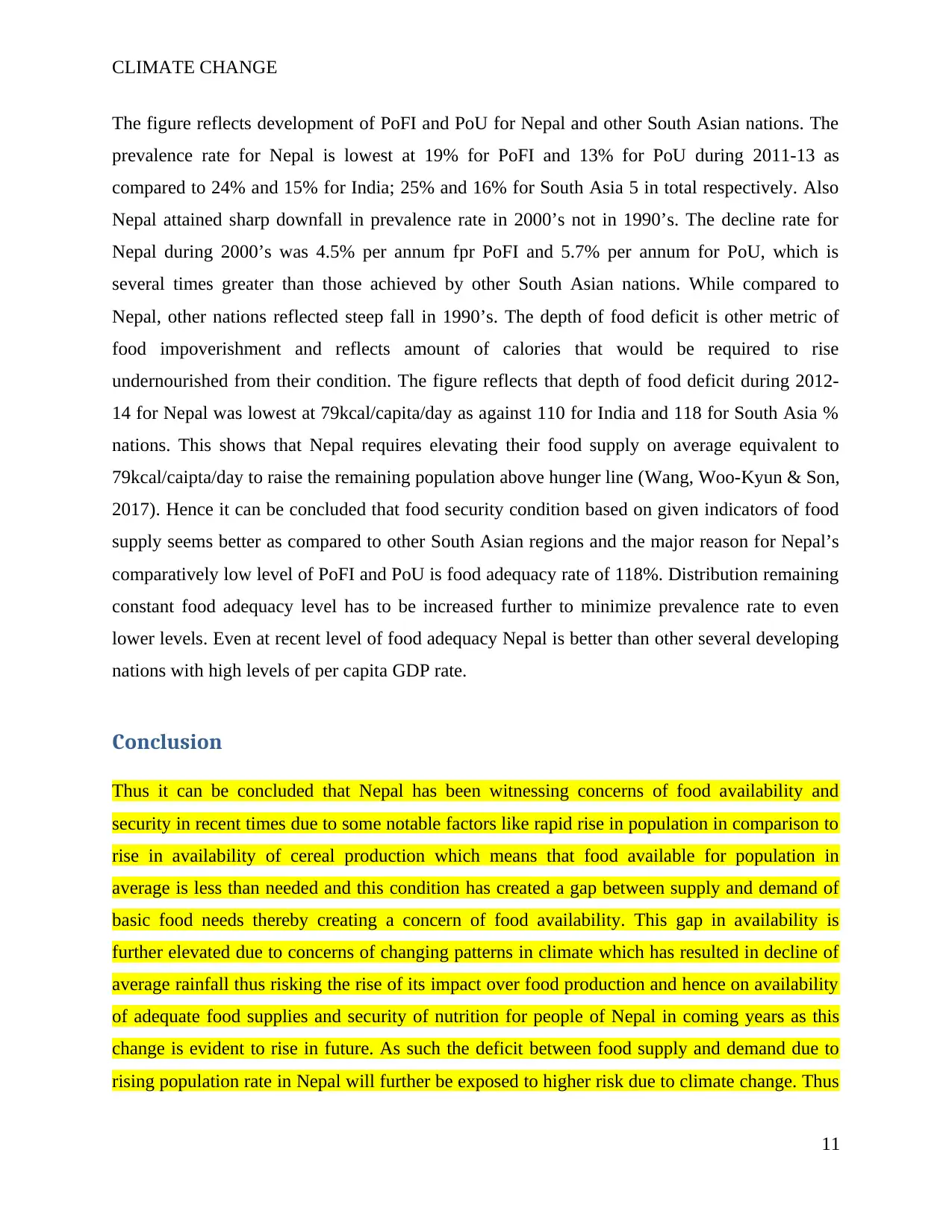
CLIMATE CHANGE
The figure reflects development of PoFI and PoU for Nepal and other South Asian nations. The
prevalence rate for Nepal is lowest at 19% for PoFI and 13% for PoU during 2011-13 as
compared to 24% and 15% for India; 25% and 16% for South Asia 5 in total respectively. Also
Nepal attained sharp downfall in prevalence rate in 2000’s not in 1990’s. The decline rate for
Nepal during 2000’s was 4.5% per annum fpr PoFI and 5.7% per annum for PoU, which is
several times greater than those achieved by other South Asian nations. While compared to
Nepal, other nations reflected steep fall in 1990’s. The depth of food deficit is other metric of
food impoverishment and reflects amount of calories that would be required to rise
undernourished from their condition. The figure reflects that depth of food deficit during 2012-
14 for Nepal was lowest at 79kcal/capita/day as against 110 for India and 118 for South Asia %
nations. This shows that Nepal requires elevating their food supply on average equivalent to
79kcal/caipta/day to raise the remaining population above hunger line (Wang, Woo-Kyun & Son,
2017). Hence it can be concluded that food security condition based on given indicators of food
supply seems better as compared to other South Asian regions and the major reason for Nepal’s
comparatively low level of PoFI and PoU is food adequacy rate of 118%. Distribution remaining
constant food adequacy level has to be increased further to minimize prevalence rate to even
lower levels. Even at recent level of food adequacy Nepal is better than other several developing
nations with high levels of per capita GDP rate.
Conclusion
Thus it can be concluded that Nepal has been witnessing concerns of food availability and
security in recent times due to some notable factors like rapid rise in population in comparison to
rise in availability of cereal production which means that food available for population in
average is less than needed and this condition has created a gap between supply and demand of
basic food needs thereby creating a concern of food availability. This gap in availability is
further elevated due to concerns of changing patterns in climate which has resulted in decline of
average rainfall thus risking the rise of its impact over food production and hence on availability
of adequate food supplies and security of nutrition for people of Nepal in coming years as this
change is evident to rise in future. As such the deficit between food supply and demand due to
rising population rate in Nepal will further be exposed to higher risk due to climate change. Thus
11
The figure reflects development of PoFI and PoU for Nepal and other South Asian nations. The
prevalence rate for Nepal is lowest at 19% for PoFI and 13% for PoU during 2011-13 as
compared to 24% and 15% for India; 25% and 16% for South Asia 5 in total respectively. Also
Nepal attained sharp downfall in prevalence rate in 2000’s not in 1990’s. The decline rate for
Nepal during 2000’s was 4.5% per annum fpr PoFI and 5.7% per annum for PoU, which is
several times greater than those achieved by other South Asian nations. While compared to
Nepal, other nations reflected steep fall in 1990’s. The depth of food deficit is other metric of
food impoverishment and reflects amount of calories that would be required to rise
undernourished from their condition. The figure reflects that depth of food deficit during 2012-
14 for Nepal was lowest at 79kcal/capita/day as against 110 for India and 118 for South Asia %
nations. This shows that Nepal requires elevating their food supply on average equivalent to
79kcal/caipta/day to raise the remaining population above hunger line (Wang, Woo-Kyun & Son,
2017). Hence it can be concluded that food security condition based on given indicators of food
supply seems better as compared to other South Asian regions and the major reason for Nepal’s
comparatively low level of PoFI and PoU is food adequacy rate of 118%. Distribution remaining
constant food adequacy level has to be increased further to minimize prevalence rate to even
lower levels. Even at recent level of food adequacy Nepal is better than other several developing
nations with high levels of per capita GDP rate.
Conclusion
Thus it can be concluded that Nepal has been witnessing concerns of food availability and
security in recent times due to some notable factors like rapid rise in population in comparison to
rise in availability of cereal production which means that food available for population in
average is less than needed and this condition has created a gap between supply and demand of
basic food needs thereby creating a concern of food availability. This gap in availability is
further elevated due to concerns of changing patterns in climate which has resulted in decline of
average rainfall thus risking the rise of its impact over food production and hence on availability
of adequate food supplies and security of nutrition for people of Nepal in coming years as this
change is evident to rise in future. As such the deficit between food supply and demand due to
rising population rate in Nepal will further be exposed to higher risk due to climate change. Thus
11
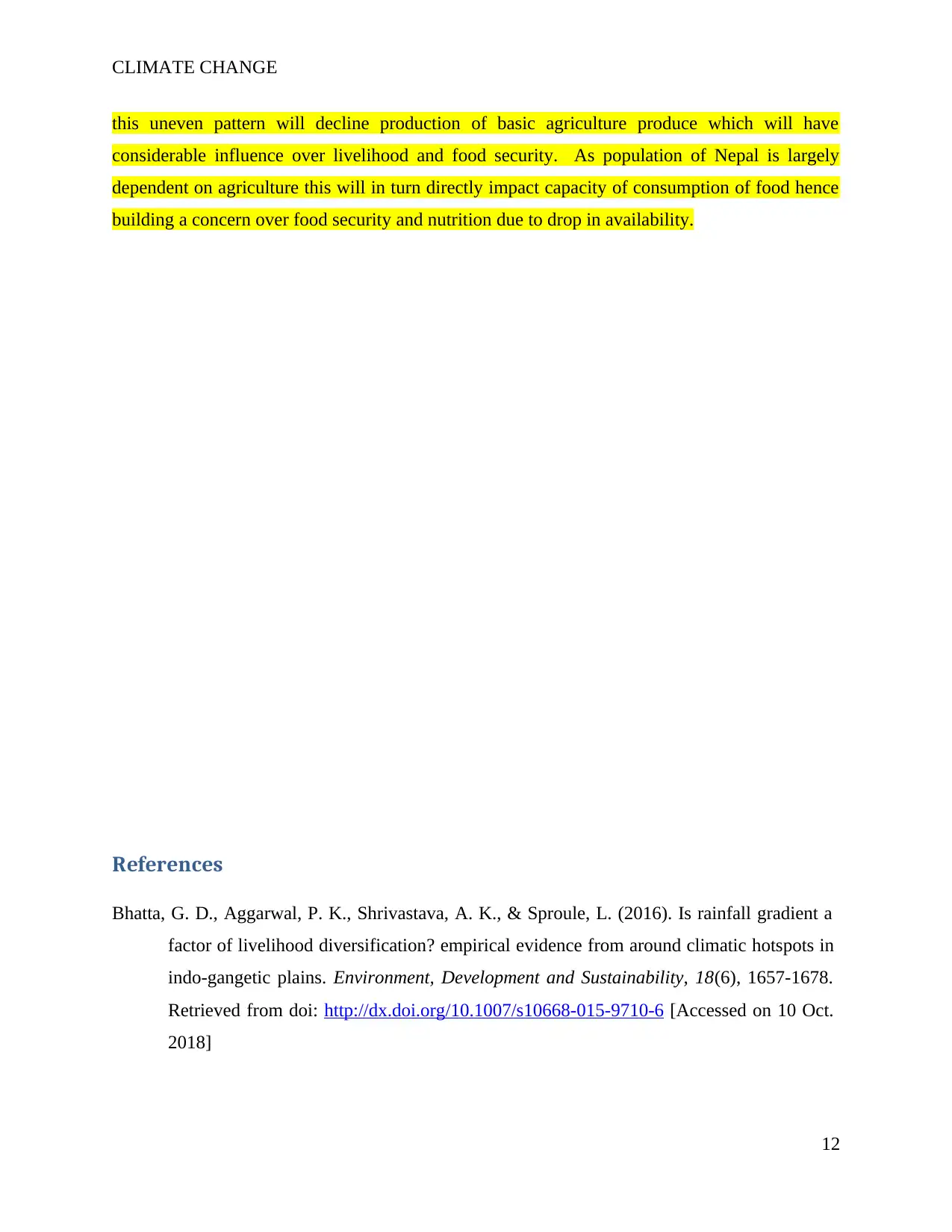
CLIMATE CHANGE
this uneven pattern will decline production of basic agriculture produce which will have
considerable influence over livelihood and food security. As population of Nepal is largely
dependent on agriculture this will in turn directly impact capacity of consumption of food hence
building a concern over food security and nutrition due to drop in availability.
References
Bhatta, G. D., Aggarwal, P. K., Shrivastava, A. K., & Sproule, L. (2016). Is rainfall gradient a
factor of livelihood diversification? empirical evidence from around climatic hotspots in
indo-gangetic plains. Environment, Development and Sustainability, 18(6), 1657-1678.
Retrieved from doi: http://dx.doi.org/10.1007/s10668-015-9710-6 [Accessed on 10 Oct.
2018]
12
this uneven pattern will decline production of basic agriculture produce which will have
considerable influence over livelihood and food security. As population of Nepal is largely
dependent on agriculture this will in turn directly impact capacity of consumption of food hence
building a concern over food security and nutrition due to drop in availability.
References
Bhatta, G. D., Aggarwal, P. K., Shrivastava, A. K., & Sproule, L. (2016). Is rainfall gradient a
factor of livelihood diversification? empirical evidence from around climatic hotspots in
indo-gangetic plains. Environment, Development and Sustainability, 18(6), 1657-1678.
Retrieved from doi: http://dx.doi.org/10.1007/s10668-015-9710-6 [Accessed on 10 Oct.
2018]
12
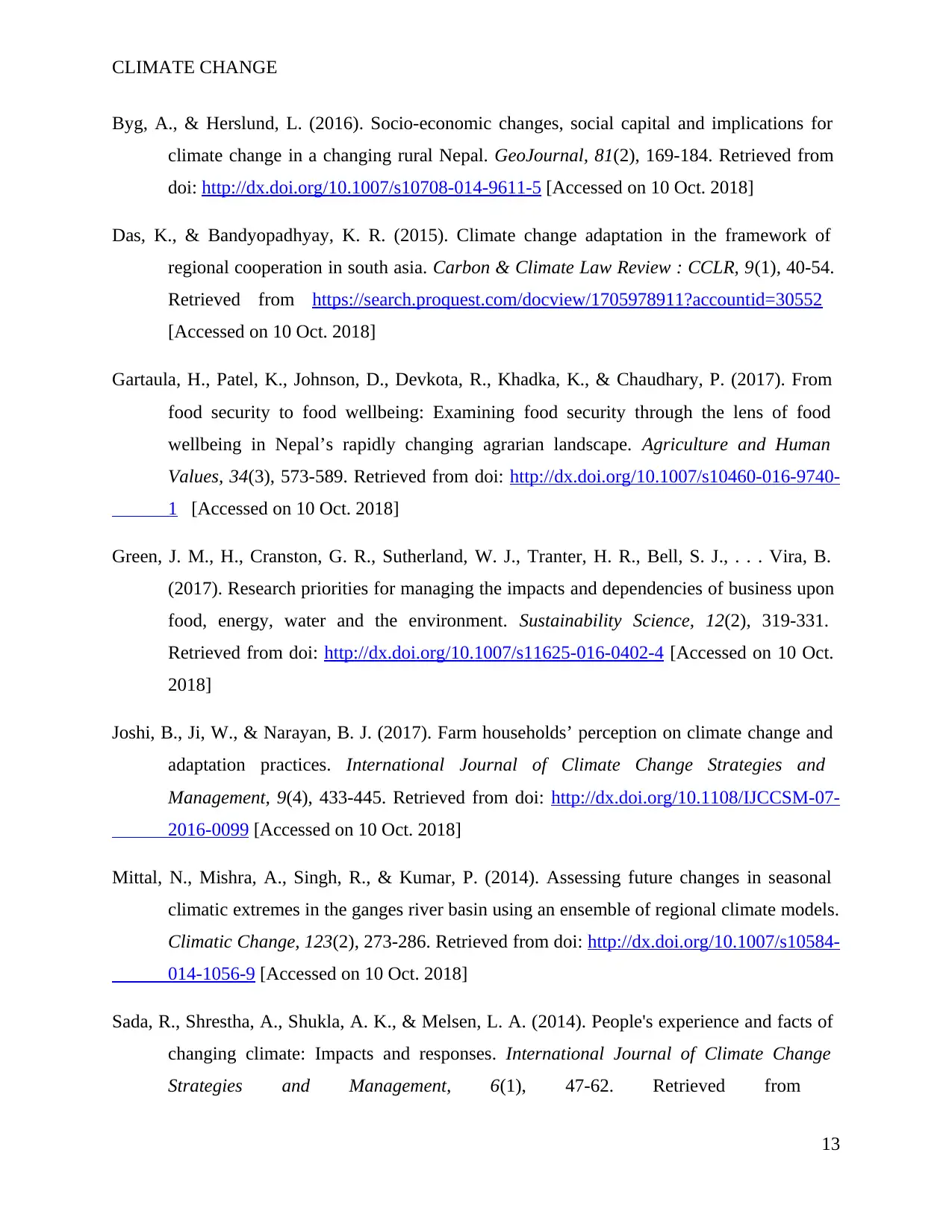
CLIMATE CHANGE
Byg, A., & Herslund, L. (2016). Socio-economic changes, social capital and implications for
climate change in a changing rural Nepal. GeoJournal, 81(2), 169-184. Retrieved from
doi: http://dx.doi.org/10.1007/s10708-014-9611-5 [Accessed on 10 Oct. 2018]
Das, K., & Bandyopadhyay, K. R. (2015). Climate change adaptation in the framework of
regional cooperation in south asia. Carbon & Climate Law Review : CCLR, 9(1), 40-54.
Retrieved from https://search.proquest.com/docview/1705978911?accountid=30552
[Accessed on 10 Oct. 2018]
Gartaula, H., Patel, K., Johnson, D., Devkota, R., Khadka, K., & Chaudhary, P. (2017). From
food security to food wellbeing: Examining food security through the lens of food
wellbeing in Nepal’s rapidly changing agrarian landscape. Agriculture and Human
Values, 34(3), 573-589. Retrieved from doi: http://dx.doi.org/10.1007/s10460-016-9740-
1 [Accessed on 10 Oct. 2018]
Green, J. M., H., Cranston, G. R., Sutherland, W. J., Tranter, H. R., Bell, S. J., . . . Vira, B.
(2017). Research priorities for managing the impacts and dependencies of business upon
food, energy, water and the environment. Sustainability Science, 12(2), 319-331.
Retrieved from doi: http://dx.doi.org/10.1007/s11625-016-0402-4 [Accessed on 10 Oct.
2018]
Joshi, B., Ji, W., & Narayan, B. J. (2017). Farm households’ perception on climate change and
adaptation practices. International Journal of Climate Change Strategies and
Management, 9(4), 433-445. Retrieved from doi: http://dx.doi.org/10.1108/IJCCSM-07-
2016-0099 [Accessed on 10 Oct. 2018]
Mittal, N., Mishra, A., Singh, R., & Kumar, P. (2014). Assessing future changes in seasonal
climatic extremes in the ganges river basin using an ensemble of regional climate models.
Climatic Change, 123(2), 273-286. Retrieved from doi: http://dx.doi.org/10.1007/s10584-
014-1056-9 [Accessed on 10 Oct. 2018]
Sada, R., Shrestha, A., Shukla, A. K., & Melsen, L. A. (2014). People's experience and facts of
changing climate: Impacts and responses. International Journal of Climate Change
Strategies and Management, 6(1), 47-62. Retrieved from
13
Byg, A., & Herslund, L. (2016). Socio-economic changes, social capital and implications for
climate change in a changing rural Nepal. GeoJournal, 81(2), 169-184. Retrieved from
doi: http://dx.doi.org/10.1007/s10708-014-9611-5 [Accessed on 10 Oct. 2018]
Das, K., & Bandyopadhyay, K. R. (2015). Climate change adaptation in the framework of
regional cooperation in south asia. Carbon & Climate Law Review : CCLR, 9(1), 40-54.
Retrieved from https://search.proquest.com/docview/1705978911?accountid=30552
[Accessed on 10 Oct. 2018]
Gartaula, H., Patel, K., Johnson, D., Devkota, R., Khadka, K., & Chaudhary, P. (2017). From
food security to food wellbeing: Examining food security through the lens of food
wellbeing in Nepal’s rapidly changing agrarian landscape. Agriculture and Human
Values, 34(3), 573-589. Retrieved from doi: http://dx.doi.org/10.1007/s10460-016-9740-
1 [Accessed on 10 Oct. 2018]
Green, J. M., H., Cranston, G. R., Sutherland, W. J., Tranter, H. R., Bell, S. J., . . . Vira, B.
(2017). Research priorities for managing the impacts and dependencies of business upon
food, energy, water and the environment. Sustainability Science, 12(2), 319-331.
Retrieved from doi: http://dx.doi.org/10.1007/s11625-016-0402-4 [Accessed on 10 Oct.
2018]
Joshi, B., Ji, W., & Narayan, B. J. (2017). Farm households’ perception on climate change and
adaptation practices. International Journal of Climate Change Strategies and
Management, 9(4), 433-445. Retrieved from doi: http://dx.doi.org/10.1108/IJCCSM-07-
2016-0099 [Accessed on 10 Oct. 2018]
Mittal, N., Mishra, A., Singh, R., & Kumar, P. (2014). Assessing future changes in seasonal
climatic extremes in the ganges river basin using an ensemble of regional climate models.
Climatic Change, 123(2), 273-286. Retrieved from doi: http://dx.doi.org/10.1007/s10584-
014-1056-9 [Accessed on 10 Oct. 2018]
Sada, R., Shrestha, A., Shukla, A. K., & Melsen, L. A. (2014). People's experience and facts of
changing climate: Impacts and responses. International Journal of Climate Change
Strategies and Management, 6(1), 47-62. Retrieved from
13
Paraphrase This Document
Need a fresh take? Get an instant paraphrase of this document with our AI Paraphraser

CLIMATE CHANGE
https://search.proquest.com/docview/1493448243?accountid=30552 [Accessed on 10
Oct. 2018]
Shah, R. D., Tachamo, Sharma, S., Haase, P., Jähnig, S.,C., & Pauls, S. U. (2015). The climate
sensitive zone along an altitudinal gradient in central himalayan rivers: A useful concept
to monitor climate change impacts in mountain regions. Climatic Change, 132(2), 265-
278. Retrieved from doi: http://dx.doi.org/10.1007/s10584-015-1417-z [Accessed on 10
Oct. 2018]
Stewart, F. (2016). Changing perspectives on inequality and development. Studies in
Comparative International Development, 51(1), 60-80. Retrieved from doi:
http://dx.doi.org/10.1007/s12116-016-9222-x [Accessed on 10 Oct. 2018]
te Lintelo, D.,J.H., & Lakshman, R. W. D. (2015). Equate and conflate: Political commitment to
hunger and under nutrition reduction in five high-burden countries. World Development,
76, 280. Retrieved from doi: http://dx.doi.org/10.1016/j.worlddev.2015.07.013 [Accessed
on 10 Oct. 2018]
Wang, S. W., Woo-Kyun, L., & Son, Y. (2017). An assessment of climate change impacts and
adaptation in south asian agriculture. International Journal of Climate Change Strategies
and Management, 9(4), 517-534. Retrieved from: doi:
http://dx.doi.org/10.1108/IJCCSM-05-2016-0069 [Accessed on 10 Oct. 2018]
Figures & Tables
Fig 1 Pandit., J (2018). Export Potential of Agriculture and Food Products of Nepal. Retrieved
from: http://www.ips.lk/wp-content/uploads/2017/09/Nepal.pdf [Accessed on 31 Oct.
2018]
14
https://search.proquest.com/docview/1493448243?accountid=30552 [Accessed on 10
Oct. 2018]
Shah, R. D., Tachamo, Sharma, S., Haase, P., Jähnig, S.,C., & Pauls, S. U. (2015). The climate
sensitive zone along an altitudinal gradient in central himalayan rivers: A useful concept
to monitor climate change impacts in mountain regions. Climatic Change, 132(2), 265-
278. Retrieved from doi: http://dx.doi.org/10.1007/s10584-015-1417-z [Accessed on 10
Oct. 2018]
Stewart, F. (2016). Changing perspectives on inequality and development. Studies in
Comparative International Development, 51(1), 60-80. Retrieved from doi:
http://dx.doi.org/10.1007/s12116-016-9222-x [Accessed on 10 Oct. 2018]
te Lintelo, D.,J.H., & Lakshman, R. W. D. (2015). Equate and conflate: Political commitment to
hunger and under nutrition reduction in five high-burden countries. World Development,
76, 280. Retrieved from doi: http://dx.doi.org/10.1016/j.worlddev.2015.07.013 [Accessed
on 10 Oct. 2018]
Wang, S. W., Woo-Kyun, L., & Son, Y. (2017). An assessment of climate change impacts and
adaptation in south asian agriculture. International Journal of Climate Change Strategies
and Management, 9(4), 517-534. Retrieved from: doi:
http://dx.doi.org/10.1108/IJCCSM-05-2016-0069 [Accessed on 10 Oct. 2018]
Figures & Tables
Fig 1 Pandit., J (2018). Export Potential of Agriculture and Food Products of Nepal. Retrieved
from: http://www.ips.lk/wp-content/uploads/2017/09/Nepal.pdf [Accessed on 31 Oct.
2018]
14
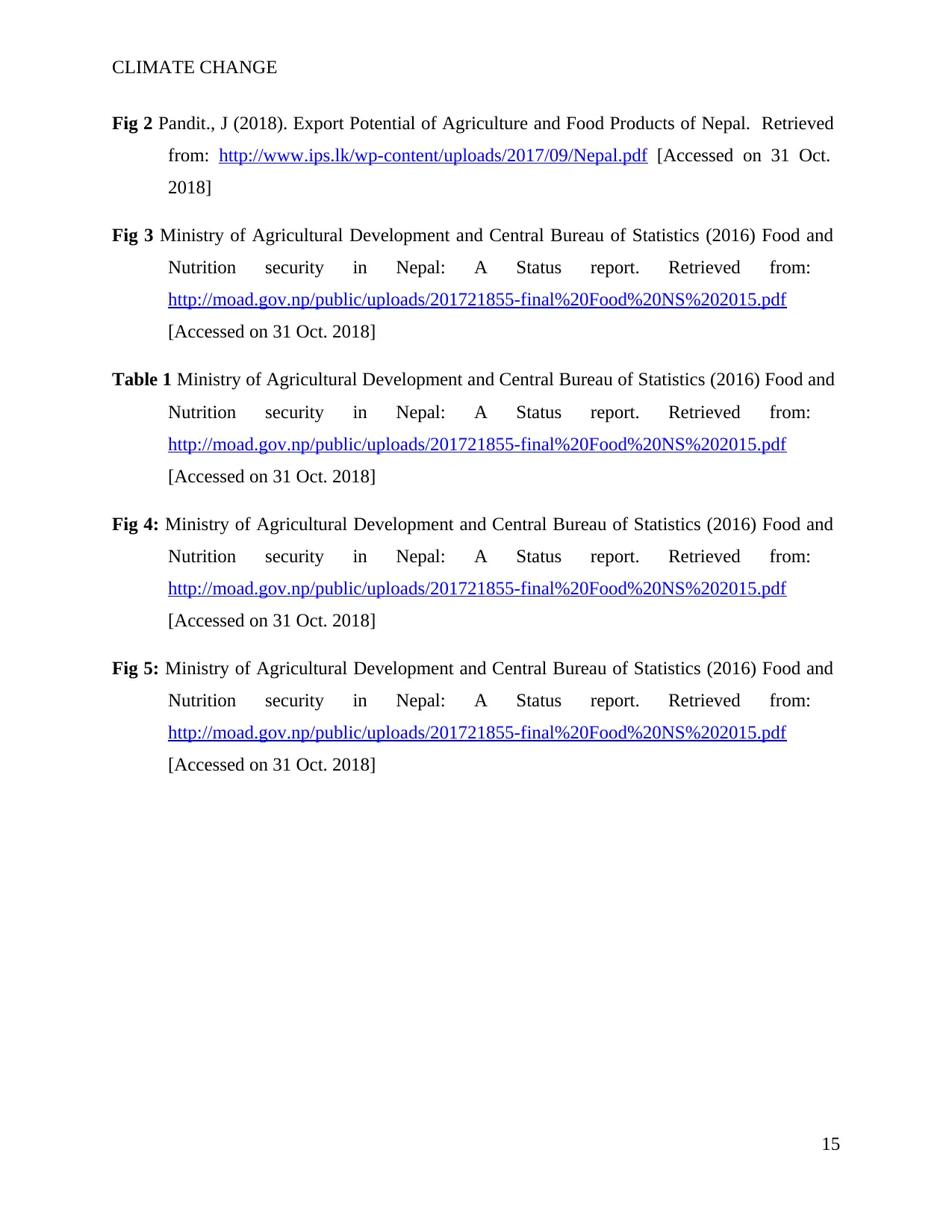
CLIMATE CHANGE
Fig 2 Pandit., J (2018). Export Potential of Agriculture and Food Products of Nepal. Retrieved
from: http://www.ips.lk/wp-content/uploads/2017/09/Nepal.pdf [Accessed on 31 Oct.
2018]
Fig 3 Ministry of Agricultural Development and Central Bureau of Statistics (2016) Food and
Nutrition security in Nepal: A Status report. Retrieved from:
http://moad.gov.np/public/uploads/201721855-final%20Food%20NS%202015.pdf
[Accessed on 31 Oct. 2018]
Table 1 Ministry of Agricultural Development and Central Bureau of Statistics (2016) Food and
Nutrition security in Nepal: A Status report. Retrieved from:
http://moad.gov.np/public/uploads/201721855-final%20Food%20NS%202015.pdf
[Accessed on 31 Oct. 2018]
Fig 4: Ministry of Agricultural Development and Central Bureau of Statistics (2016) Food and
Nutrition security in Nepal: A Status report. Retrieved from:
http://moad.gov.np/public/uploads/201721855-final%20Food%20NS%202015.pdf
[Accessed on 31 Oct. 2018]
Fig 5: Ministry of Agricultural Development and Central Bureau of Statistics (2016) Food and
Nutrition security in Nepal: A Status report. Retrieved from:
http://moad.gov.np/public/uploads/201721855-final%20Food%20NS%202015.pdf
[Accessed on 31 Oct. 2018]
15
Fig 2 Pandit., J (2018). Export Potential of Agriculture and Food Products of Nepal. Retrieved
from: http://www.ips.lk/wp-content/uploads/2017/09/Nepal.pdf [Accessed on 31 Oct.
2018]
Fig 3 Ministry of Agricultural Development and Central Bureau of Statistics (2016) Food and
Nutrition security in Nepal: A Status report. Retrieved from:
http://moad.gov.np/public/uploads/201721855-final%20Food%20NS%202015.pdf
[Accessed on 31 Oct. 2018]
Table 1 Ministry of Agricultural Development and Central Bureau of Statistics (2016) Food and
Nutrition security in Nepal: A Status report. Retrieved from:
http://moad.gov.np/public/uploads/201721855-final%20Food%20NS%202015.pdf
[Accessed on 31 Oct. 2018]
Fig 4: Ministry of Agricultural Development and Central Bureau of Statistics (2016) Food and
Nutrition security in Nepal: A Status report. Retrieved from:
http://moad.gov.np/public/uploads/201721855-final%20Food%20NS%202015.pdf
[Accessed on 31 Oct. 2018]
Fig 5: Ministry of Agricultural Development and Central Bureau of Statistics (2016) Food and
Nutrition security in Nepal: A Status report. Retrieved from:
http://moad.gov.np/public/uploads/201721855-final%20Food%20NS%202015.pdf
[Accessed on 31 Oct. 2018]
15

CLIMATE CHANGE
http://www.ips.lk/wp-content/uploads/2017/09/Nepal.pdf
http://www.fao.org/fileadmin/templates/ess/documents/apcas26/presentations/APCAS-16-
6.4.4_-_Nepal_-_Food_Security.pdf
16
http://www.ips.lk/wp-content/uploads/2017/09/Nepal.pdf
http://www.fao.org/fileadmin/templates/ess/documents/apcas26/presentations/APCAS-16-
6.4.4_-_Nepal_-_Food_Security.pdf
16
Secure Best Marks with AI Grader
Need help grading? Try our AI Grader for instant feedback on your assignments.

CLIMATE CHANGE
17
17
1 out of 17
Related Documents
Your All-in-One AI-Powered Toolkit for Academic Success.
+13062052269
info@desklib.com
Available 24*7 on WhatsApp / Email
![[object Object]](/_next/static/media/star-bottom.7253800d.svg)
Unlock your academic potential
© 2024 | Zucol Services PVT LTD | All rights reserved.





